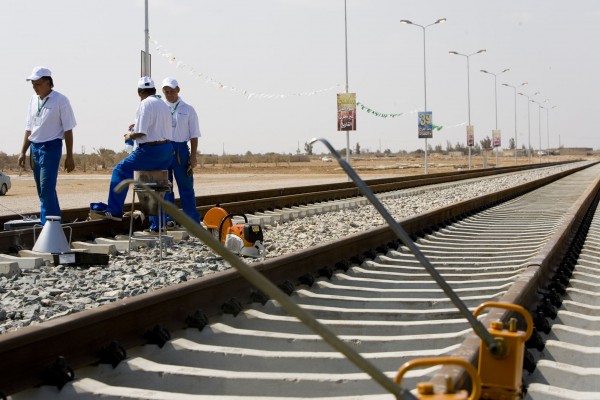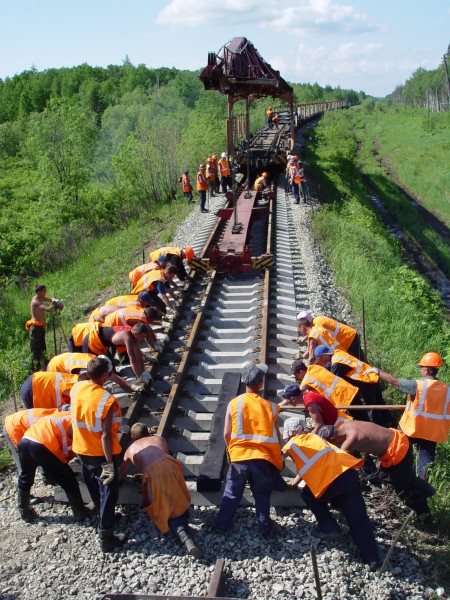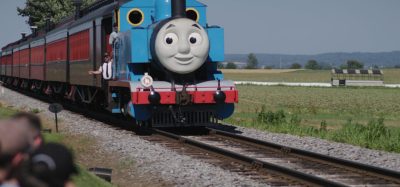Russia’s role in increasing international rail transportation
Posted: 31 May 2010 | | No comments yet
The issue of increasing the role of international rail transportation between Europe and Asia has recently been growing in significance. Countries of the Asia-Pacific region, primarily China, are maintaining positive economic growth trends despite the global recession, and potential for boosting their foreign trade, including with European Union countries. Russia, being a natural transport bridge between Europe and Asia, can play an important role in this trade. Therefore, one of the main goals set out in the Strategy for Developing Rail Transport up to 2030 approved by the Russian government is deep integration into the Eurasian transport system.
The issue of increasing the role of international rail transportation between Europe and Asia has recently been growing in significance. Countries of the Asia-Pacific region, primarily China, are maintaining positive economic growth trends despite the global recession, and potential for boosting their foreign trade, including with European Union countries. Russia, being a natural transport bridge between Europe and Asia, can play an important role in this trade. Therefore, one of the main goals set out in the Strategy for Developing Rail Transport up to 2030 approved by the Russian government is deep integration into the Eurasian transport system.
The issue of increasing the role of international rail transportation between Europe and Asia has recently been growing in significance. Countries of the Asia-Pacific region, primarily China, are maintaining positive economic growth trends despite the global recession, and potential for boosting their foreign trade, including with European Union countries. Russia, being a natural transport bridge between Europe and Asia, can play an important role in this trade. Therefore, one of the main goals set out in the Strategy for Developing Rail Transport up to 2030 approved by the Russian government is deep integration into the Eurasian transport system.
To this extent, the company has set itself the following goals:
- To increase the role of the Russian rail network on the global – primarily Eurasian – market of transport services
- To strengthen Russian Railways’ competitiveness compared to alternative forms of transport and foreign shipment companies
- To fulfill the transport potential of the Russian rail network as effectively as possible
Due to the impossibility of intensively developing railway transportation without attracting substantial financial resources, Russian Railways is, despite the economic crisis, implementing a large-scale investment strategy. In 2009, the company’s investment programme totalled $8.76 billion (262.8 billion rubles).
In line with the strategy, the planned total volume of investment in developing rail transport in Russia up to 2030 is $450 billion. The key element of existing transport flows via Russian territory is freight on routes linking Central Asia with Ukraine, Belarus and the European Union. The main cargoes are oil, ferrous metals, chemicals, coal, ore, and grain.
International ‘East-West’ transport corridor
In the near future, the main transit flows should comprise container freight on key international transport corridors – most importantly, the trans-continental ‘East-West’ route, of which the Trans-Siberian route is the basis.
In the projects of the international organisations UNECE, UNESCAP, and OSJD, the Trans-Siberian route is included as a priority route in links between Europe and Asia. In recent years, the quality of transport services has improved on the Trans-Siberian route, freight safeguarding issues have been resolved, and a simplified procedure has been introduced for cargo declaration. Modern information technology enables the movement of carriages and containers to be monitored in real-time.
In the future (based on the strategy), over 400km of new lines will be built to bypass major rail hubs, along with more than 700km of additional trunk routes. Total investment in developing the East-West corridor during the period up to 2030 is planned to exceed $26 billion (in 2007 prices).
In 2008, more than 600,000 TEU of large-tonnage containers with foreign-trade cargo passed along the Trans-Siberian route (of which 29,000 TEU was transit freight). In 2009, the volume more than halved, and transit freight declined by almost 40% (to 18,000 TEU).


Russian Railways is determined to increase its role and to strengthen its competitiveness
Priority targets for the Trans- Siberian ‘In 7 Days’ product
In our ‘Programme of action for developing container freight using the Trans-Siberian route up to 2015’, we plan to gradually increase the speed of the route, and shorten timeframes for the delivery of transit container freight along the Nakhodka-Krasnoye route, from the current 910km/day to 1,400km/day by 2012, and to 1,500km/day by 2015.
As early as 2012, freight delivery times from Russia’s eastern to western borders will be cut to seven days, and by 2015, the distance covered in this time will be extended to Brest. We expect that this project will enable us to attract additional volumes of transit freight to Russia’s railway system (in the medium term, more than 500,000 TEU per year).
In terms of attracting freight to the East-West corridor, trade cargo with European countries, China, South Korea and Japan are the most promising.
Cooperation with Kazakhstan could prove fruitful for attracting freight flows between the western regions of China and European countries, using the branch of the East-West corridor through the Dostyk and Kartaly border crossings.
The ‘Khasan-Rajin’ project
We are currently working on creating a new route for container freight: Rajin port (North Korea) – Tumangan (North Korea) – Khasan (Russia) – Russian rail network – Europe. The project includes the reconstruction of the Tumangan-Rajin rail track in North Korea, the construction of a container terminal at the Rajin port, and the organisation of international freight transportation using the created infrastructure.
Cooperation in developing Mongolia’s railway
The unified technological base with Mongolia and the standard rail gauge allows us to offer freight consigners effective transport services on this route.
The passage of a demonstration train from Beijing to Hamburg, organised in 2008, which covered a distance of 9,877km over 18 days through the territories of China, Mongolia, Russia, Belarus, Poland and Germany, showed the viability of this route.
Recently, a federal stake in Ulan Bator Railways was transferred to Russian Railways on a beneficial ownership basis. In cooperation with our Mongolian colleagues, a new conception has been drawn up for the development of Ulan Bator Railways and the construction of new railway infrastructure linking to mineral deposits in Mongolia.
Project to build broad 1,520mm gauge rail line from Košice to Bratislava and Vienna
The goal of the project is to link the railway systems of Central Europe with regions on the Trans-Siberian route, attract freight to the Asia- Russia-Central Europe route, and to raise the competitiveness of rail transportation.
In 2009, a four-way joint venture was set up, and was assigned the role coordinating the construction of rail lines and a logistic traffic terminal, evaluating the economic effectiveness of the project, conducting a feasibility study, and attracting financing.
Subsidiaries are also actively developing international cooperation. In particular, in mid- 2009, TransContainer obtained a long-term lease agreement on the Dobra terminal in Slovakia, with the aim of developing container transportation on international transport corridor No. 5.
The international ‘North-South’ transport corridor
Another of our goals is to form an integrated railway infrastructure on the North-South international transport corridor. A land bridge will be created for the first time extending almost 45,000km from the Baltic Sea to the Bandar-Abbas port in the Persian Gulf, which will link Northwest and Central Europe to countries of the Near and Middle East, and South Asia.
According to expert estimates, the goods market for the international North-South corridor totals 25-26 million tonnes by 2015.
More than $13 billion is planned to be invested in increasing the throughput capacity of sections of the Russian Railway network.
It is worth noting that in line with its international obligations, Russia is helping countries located in the centre of the Eurasian continent to gain access to the sea.
In particular, Russian Railways is aiding the creation of competitive conditions for the use of Baltic and Black Sea ports in transporting foreign-trade freight from Central Asian countries.


The planned total volume of investment in developing rail transport in Russia by 2030 is $450 billion
Cooperation with foreign transport companies in creating joint ventures
The existence of appropriate market infrastructure represents one more necessary condition for improving the competitive advantages of the rail system. Joint ventures are created with this goal in view.
Germany
In particular, the joint venture Trans Eurasia Logistics (TEL) was set up in 2008 with Deutsche Bahn. The goal of the joint venture is to boost transportation volumes by improving the quality of services and creating a unified end-to-end service for freight transportation.
Finland
Work to provide a comprehensive service in container freight on export, import and transit routes between Russia and Finland is being conducted through the ContainerTransScandinavia joint venture set up in 2007 by TransContainer and VR Group Ltd (Finnish Railways). It should be noted that the Russian and Finnish railways have all the necessary conditions for effective work: in 2010, the countries are maintaining exclusive tariff terms for transportation of containers, coal, petrochemicals, and a range of other cargoes.
China
The joint venture set up in October 2009 between TransContainer and China Railway Container Transport Corp. (CRCT) is working on providing the full range of transport-logistical services for freight transport in containers on China-Russia and China-Europe rail links.
Japan
Our subsidiaries, TransContainer and Russkaya Troika, signed agent agreements with major Japanese forwarding agents, enabling the successful promotion of their services on the Japanese market. The positive reception from Japanese businesses circles to the demonstration of the Trans-Siberian rail route’s potential allows us to predict a positive outlook for attracting Japanese freight.
Multimodal transportation
The strengthening of Eurasian links is dependant to a large extent on close cooperation between various forms of transport, and the creation of multimodal logistical chains. Under the Strategy-2030, a core network of terminal-logistic centres will be set up in the largest transport hubs and industrial zones of the country, primarily those used by participants in international corridors.
Russian ports
Russian Railways has recently been actively investing funds into the construction of rail approaches to Russian ports on all water bodies. At the same time, the company and its subsidiaries are contributing to the capital of sea ports, in order to arrange efficient logistics for intermodal transport.
The ferry route linking Ust Luga, Baltiysk, and Germany’s ports
To swiftly resolve ferry transport development issues, the Russian-German council of the combined car and rail freight-and-passenger ferry line Ust-Luga-Baltiysk-Sassnitz was created.
After Russia decided to join the Intergovernmental Organisation for International Carriage by Rail (OTIF) and the Convention concerning International Carriage by Rail (COTIF), this route also offered the possibility of using a common CIM/SMGS consignment note in arranging goods shipment.
The issue of organising a regular direct rail and ferry link between the ports of Kavkaz and Samsun (Turkey) is being finalised. Taking part in its creation is the Russian Railways subsidiary Black Sea Ferries Ltd, the existing freight carrier on the Kavkaz-Poti route, providing a transport link with Armenia.
Russian Railways is also working on developing effective cooperation with customs authorities through a unified electronic document interchange.
Of great importance to us is our work through the Inland Transport Committee of the UN’s Economic Commission for Europe (ITC UNECE), whose main goals are to harmonise the regulatory and legal base in the transport sphere, and to develop the transport infrastructure of European countries.
About the Author
Vladimir Yakunin
Vladimir Yakunin was appointed President of Russian Railways by the Government of the Russian Federation in June 2005.
Mr. Yakunin graduated from the Leningrad Institute of Mechanics as a Mechanical Engineer in 1972 and began his career as a Junior Research Scientist at the State Institute of Applied Chemistry. After completing military service in the Soviet Army, he worked as an Engineer and Senior Engineer at the Administration of the State Committee of the Council of Ministers of the USSR for Foreign Trade and was also Head of Department at the A. F. Yoffe Physics and Technical Institute of the Academy of Sciences of the USSR.
Between 1985 and 1991, Mr. Yakunin was Second and then First Secretary of the USSR’s Permanent Representative Office at the United Nations. He was then Chairman of the Board at the International Centre for Business Cooperation before becoming Head of the North-Western Federal District Inspectorate of the Senior Control Department of the President of the Russian Federation.
Mr. Yakunin became Deputy Minister of Transport in October 2000 and first Deputy Minister of Railways in February 2002. In October 2003, the Board of Russian Railways unanimously appointed Mr. Yakunin as First Vice-President of the Company.







